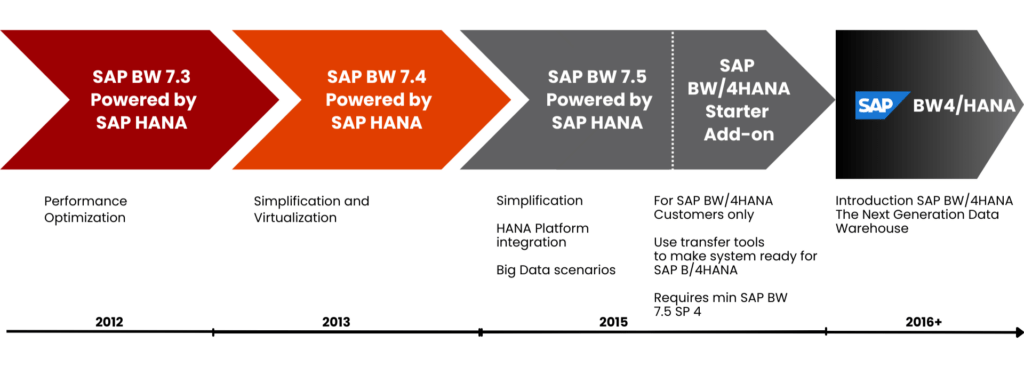Introduction to SAP Business Warehouse
SAP users can react quickly and effortlessly to the corporate needs of new models and modifications to existing ones because the warehouse structure has been significantly simplified and it has a new data flow modeler. Using SAP Business Objects Cloud or SAP Lumira to visualize the data, users may automatically create views from objects, modify them with any SQL query, and produce views from other objects. Agile database development is made possible by this, providing organizations with better insights in real-time and for less money.
Additionally, the system has various on-premises and cloud deployment choices. Customers can quickly and easily set up their infrastructure using cloud deployment, which also delivers exceptional value for money. Currently, SAP HANA Enterprise Cloud, Amazon Web Services, and Microsoft Azure allow the deployment of the cloud version of SAP.
The brand-new BW solution makes data life-cycle management, data flow, and data structures simpler. Any non-SAP data in the firms can be accessed because of its connections to SAP HANA and enterprise information management (EIM). Additionally, it has the newest user interfaces (UI) for administrators, BW modelers, and end users, as well as the potent in-memory SAP HANA platform, which offers great speed.
History of SAP Business Warehouse
Historically, BW was built on top of SAP’s transactional system R/3, which was designed for online transaction processing (OLTP), to provide online analytical processing (OLAP). When BW first launched, its primary goal was to extract data from SAP systems and generate reports using that data. However, it added more features and flexibility rather fast. It evolved into a fully functional data warehouse system with its 3.X editions, offering features like data gathering, data transformation, storage in relational and flat cube models, a flexible query system, and a suite of reporting and business intelligence tools underneath the label of Business Explorer.
The 3.X versions were immediately followed by the 7.X versions, which included more functionality and a more straightforward method of data manipulation, continuing this transformation. Although the system could be utilized outside of an SAP environment, SAP’s R/3 and CRM customers continued to use it nearly exclusively.
As the SAP HANA in-memory database became much more popularly employed, SAP developed a series of BW versions based on HANA. The BW Accelerator, which served as a columnar query cache for BW data models in the 7.x versions, was the first indication of them. Then came a version called BW on HANA, which included improvements tailored to the HANA database and was based on BW 7.x versions but only ran on the HANA database. BW/4HANA became accessible in 2017. It is a newer version of BW that got rid of a lot of the old functionality and included some new ones that are better suited to the columnar in-memory architecture of HANA.
Working of SAP Business Warehouse:
BW has historically been somewhat unique among data warehousing technologies in that it is entirely model-driven by default. This means that a BW developer utilizes the BW interface to define the data flow and storage of a data warehousing scenario, and BW takes care of creating the model on the database and managing the processes to acquire, transform, and store data.
To construct their data warehousing scenarios for BW specifically, developers would log in to SAP GUI and use transaction codes like RSA1 rather than SQL and stored procedures in a database management system. With the advent of open-source Eclipse and web-based tooling built on the SAP Fiori design language, BW development activities have recently changed. The models created by these tools are then tested, deployed, and moved to quality control and production systems after being tested on a development system.
BW has been consistently operated on the SAP NetWeaver ABAP platform prior to BW on HANA, but it was database-agnostic and supported all NetWeaver-supported databases, including Oracle, Microsoft SQL Server, and IBM DB2. BW continues to run on the NetWeaver ABAP platform with BW on HANA and BW/4HANA but needs the use of the HANA database. On non-HANA databases, many customers continue to use BW 7.5, the final database-independent release.
Conclusion
BW is still expanding, primarily to accommodate more data sources, output objectives, and modeling simplification while supplying more modeling elements including data aging and spatial and predictive processing.
BW has improved its integration with cloud-based technologies like SAP Data Hub as well as the HANA data management platform in its BW/4HANA incarnation. BW/4HANA is intended by SAP to be a limitless data warehouse solution for modern enterprise-level organizations. Corporate and extra-corporate data are combined in data warehousing so that they can be examined for decision-making and the development of novel new products. Future releases should offer huge data lakes, machine learning, and intelligent data analysis while integrating more closely with Hadoop.
Let’s look into detail on the SAP BW/4HANA in our next blog, until then stay tuned with us!
Also click here, to find out how KaarTech can help you to transform your organization!
FAQ’s
What is SAP BW?
The SAP Business Warehouse system is a data storage and retrieval system. Data is loaded into the Business Warehouse system, where it can be aggregated, exported, analysed, and created as a report.
How SAP NetWeaver Helps the Business warehouse to analyse data?
SAP NetWeaver BW enables the grouping and formatting of huge volumes of business data in an Enterprise Data Warehouse. By analysing data in SAP BEx using BI tools and Enterprise Planning tools.
How can SAP BusinessObjects Cloud help with SAP BW activity management?
With SAP BusinessObjects Cloud, users have the ability to define formulas for different accounts, manage currency conversion tables and allocations, and manage multiple data scenarios concurrently.
Why to adopt SAP business warehouse?
SAP business warehouse assist industrial companies in becoming more agile by improving their supply chain visibility and management, facilitating cost-cutting measures, and enhancing their quality management.


